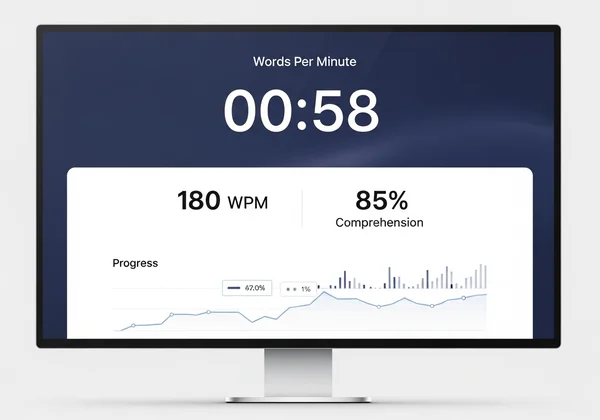ESL Reading Speed Test: How to Boost Your English WPM & Comprehension
Feeling overwhelmed by English texts? You are not alone. Many English as a Second Language (ESL) learners find it challenging to read quickly while fully understanding the material. The constant need to look up words or re-read sentences can be frustrating. How can I improve my reading speed and comprehension? This guide is designed to answer that question by providing actionable strategies tailored for non-native speakers. We will explore the unique hurdles you face and offer practical techniques to help you read faster and understand more deeply.
The first step to improvement is knowing your starting point. Before diving into these strategies, take a free reading speed test to discover your current pace. This baseline will be your benchmark for success.

Unique Challenges of Second Language Reading
Reading in a second language presents a distinct set of obstacles that native speakers don't typically encounter. Understanding these challenges is the first step toward overcoming them. It’s not just about seeing words; it’s about processing them efficiently without the ingrained familiarity of your mother tongue.
Overcoming Mental Translation Habits
As an ESL reader, you might find that one of the biggest hurdles is the habit of translating words into your native language as you read. This creates an extra cognitive step, effectively making you read everything twice. To break this habit, immerse yourself in English. Start thinking in English by narrating your daily activities internally. This practice helps build a direct connection between English words and their meanings, bypassing the need for translation. The goal is to make English your language of thought, not just a code to be deciphered.
Expanding Your ESL Vocabulary Effectively
Encountering unfamiliar words can bring your reading to a grinding halt. While building a robust vocabulary is a long-term project, you can adopt smarter strategies. Instead of memorizing random word lists, focus on learning words in context. When you find a new word, pay attention to the surrounding sentence to infer its meaning. Additionally, learning common prefixes, suffixes, and root words can empower you to decode unfamiliar terms without reaching for a dictionary every time.

Navigating Cultural Context and Idioms
Language is deeply intertwined with culture. English is full of idioms, slang, and cultural references that can be baffling to non-native speakers. A phrase like "bite the bullet" has a meaning far removed from its literal words. To overcome this, expose yourself to a wide range of English media, such as movies, podcasts, and articles from different English-speaking regions. This exposure will gradually build your understanding of the cultural nuances that give the language its rich texture.
Strategies for an Enhanced reading comprehension test
Speed without understanding is useless. True reading efficiency is about absorbing information accurately and quickly. For ESL learners, strengthening comprehension is the foundation upon which speed can be built. A high score on a reading comprehension test is just as important as a high WPM.
Active Reading: Engaging with ESL Texts
If your eyes simply scan the lines, you are reading passively, which leads to poor retention. Instead, practice active reading. Before you begin, skim the headings and introduction to get a general idea of the topic. As you read, ask yourself questions about the content. What is the author’s main argument? What evidence supports it? After finishing a section, take a moment to summarize it in your own words. This engagement turns reading from a one-way reception of information into a dynamic conversation with the text.
Building Contextual Vocabulary through Reading
A powerful technique for improving both speed and comprehension is learning to use context clues. Instead of stopping to look up every new word, try to guess its meaning from the surrounding words and sentences. Often, the text itself provides synonyms, antonyms, or examples that reveal a word’s meaning. This not only saves time but also strengthens your ability to think critically in English, making you a more resilient and confident reader.
Practical Techniques to Increase Your Average Reading Speed and Efficiency
Once you have a solid comprehension strategy, you can begin to focus on increasing your pace. These techniques are designed to train your eyes and brain to process English text more efficiently. Remember, the goal is to improve your average reading speed over time through consistent practice.
Phrasing and Chunking for Fluency
Slow readers often read one word at a time. To accelerate, you must learn to read in phrases, a technique known as chunking. Instead of seeing "the-cat-sat-on-the-mat," train your eyes to see groups of words like "[the cat] [sat on] [the mat]." This reduces the number of "eye stops" (saccades) you make per line, significantly boosting your reading fluency. Start by consciously trying to see two or three words at once, and with practice, it will become second nature.

Minimizing Subvocalization in a New Language
Subvocalization is the habit of silently saying each word in your head as you read. While common, it limits your reading speed to your speaking speed. To stop subvocalization, you can try a few tricks. Gently chewing gum or humming while you read can occupy the muscles used for speech. Another effective method is to use a pointer, like your finger or a pen, to guide your eyes along the text at a pace slightly faster than your inner voice can keep up with.
Guided Reading Practice and Timed Drills
Improvement requires consistent effort and measurable practice. Set aside 15-20 minutes each day for focused timed reading. Choose a text that is slightly challenging but not overwhelming. Read for a set amount of time (e.g., five minutes) and then mark your progress. The key is to push yourself to read a little faster each time while still maintaining good comprehension. An online wpm test is the perfect tool for these drills, providing instant feedback on your performance.
Measuring and Tracking Progress with a WPM test
You can't improve what you don't measure. Using a Words Per Minute (WPM) test is essential for any ESL learner serious about improving their reading skills. A dedicated reading speed test provides the objective data you need to track your journey and stay motivated.
Why WPM Tests are Crucial for Language Learners
For an ESL learner, the benefits of WPM test are immense. It provides a clear, numerical benchmark of your current ability. Regular testing allows you to see tangible progress, which is a powerful motivator. Furthermore, a good test also measures comprehension, ensuring you are not sacrificing understanding for speed. This dual feedback helps you identify whether you need to work on your pace, your comprehension, or both.

Interpreting Your Second Language Reading Speed Results
When you take a second language reading test, don’t be discouraged if your score is lower than the average for native speakers. This is completely normal. The important metrics are your personal improvement over time and your comprehension score. A high WPM with low comprehension means you are simply skimming. Aim for a comprehension rate of 80% or higher, and focus on gradually increasing your WPM while maintaining that level of understanding.
Setting Realistic Improvement Goals
Use your initial test result to set achievable goals. Aim for a small, consistent increase, such as improving by 5-10 WPM every week. This steady approach is more sustainable than trying to double your speed overnight. Use a tool to track your progress regularly and celebrate your milestones. Consistent practice and measurement are the keys to long-term success in your English reading journey.
Accelerate Your English Reading Journey
Your journey to mastering English reading speed and comprehension is well within reach. By embracing these tailored strategies – from active engagement with texts to focused speed drills – you're equipped to transform your reading experience. Be patient, celebrate every small victory, and know that each practice session builds towards a more confident, efficient reader.
Ready to see your progress firsthand? The most empowering step is to measure your growth. Take our free, comprehensive WPM and comprehension test at ReadingSpeedTest.net today and unlock your true reading potential!
Common Questions for ESL Reading Speed
What is a good reading speed for a non-native English speaker?
A good reading speed varies greatly depending on English proficiency and the text's difficulty. While native adults average 250-300 WPM, a non-native speaker might aim for 150-200 WPM with strong comprehension as a solid intermediate goal. The best approach is to focus on personal progress rather than comparing yourself to others. The first step is to test your WPM to establish your personal baseline.
How can I effectively improve my English reading speed and comprehension?
The most effective method is a balanced approach. Combine comprehension strategies like active reading and learning vocabulary in context with speed techniques like chunking and reducing subvocalization. Crucially, you must practice consistently and track your progress with a reliable tool that measures both speed and understanding.
Does reading on a screen affect my ESL reading speed?
Yes, many people read slightly slower on screens due to factors like glare, screen resolution, and digital eye strain. To mitigate this, take regular breaks using the 20-20-20 rule (every 20 minutes, look at something 20 feet away for 20 seconds), adjust your screen’s brightness, and increase the font size for better readability.
How often should ESL learners take a reading speed test?
For active learners, taking a reading speed test once every one to two weeks is ideal. This frequency is enough to track progress without causing testing fatigue. Use the results to see if your practice methods are effective and to adjust your learning strategy accordingly.